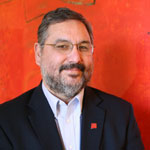When Brenda Medina came to Eisai Inc. in 2006, she joined a global clinical team with offices in New Jersey, London, Tokyo, and many other international locations. As director of clinical business operations, she manages 15 team members on two continents for the well-known prescription drug manufacturer.
The implementation of health-care reform and its regulations are changing the way pharmaceutical companies like Eisai operate. In addition to leveraging her accounting background to make sure physicians are paid on time, Medina is now obligated to publish data through government agencies—no small task for a global behemoth whose 2012 sales reached $7.9 billion. Medina led the effort to build a budgeting process and cloud-based tracking tool from scratch and introduce these to each of her international teams.
Getting to know brenda medina
An accountant by trade, Brenda Medina started her career in biotech and quickly found a mentor in the world of clinical development. She learned the ropes, observed an initial public offering in the works, and then moved on to a position at Scholastic. She returned to the pharmaceutical field by accepting a position with Eisai Inc. in 2006.
A Broad Perspective
Each product, system, and process must be tweaked for its specific destination. While the US implementation of Eisai’s health-care standards might seem simple to an American, the process changes overseas. “Unlike the United States, London manages a lot of different countries. What their doctors see and how they accept payment is different in each one,” she explains. A global director in the pharmaceutical world, therefore, must understand how the relationship between a physician and a drug manufacturer changes from location to location
As Medina has found, the intricacies seem never-ending. In parts of India, for example, public transportation is scarce and companies are asked to pay for transportation charges. “Things that are rarely paid in one context can be normal in another,” Medina says.
An Inclusive Model
According to Medina, a cross-cultural executive will enjoy the most success after taking time to build trust through sincere relationships. “I make an effort to really know my teams as a family, understand how they operate, and cater the process accordingly,” she says. What works for one team might not work for another. American teams stereotypically listen enthusiastically to cost-saving plans while Londoners may prefer to do more of their own research in advance. Medina is careful to adjust her style accordingly. “At the end of the day, I help leaders in both cultures save money, but I know upfront that how they absorb and respond to my proposal will not be the same,” she says. Executives who are technically skilled and take the time to cultivate relationships will build solid global teams that remain connected to one another. Unlike some of her peers, Medina implements all training in London first so the “foreign” teams understand that they are just as important as the “domestic” office.
Cultural Conflict
Naturally, working across three continents presents unique obstacles. For Medina, most issues have been associated with personal interpretation. The friendly and talkative executive from the Dominican Republic felt like a fish-out-of-water in the cold and sometimes sarcastic London world of business. She is often smiling and animated; her Japanese counterparts are not. “I might deliver something warmly that comes back in what I would consider harsh language. I was offended until I understood the cultural differences,” she explains. Since the differences are everywhere—from body language to vacation habits—Eisai offers American employees Japanese culture classes.
Medina has learned a lot. She knows when it’s appropriate to address someone, and when she needs to go to a third party. She understands that Americans are used to the “time is money” cliché while Europeans value time away from the office. We take our six weeks of “vacation” a few days at a time. They take their “holiday” all at once. Americans give blunt feedback, while the Japanese are more reserved.
The key to building bridges, she says, is making an effort. She tries to speak foreign languages whenever possible. “It’s difficult and embarrassing because there are mistakes, but it shows that you care,” she says, recalling a Japanese dinner during which she communicated through broken and elementary Japanese, pantomime, and amateur drawings. “Looking back, that dinner went a long way because you’re not just sharing information, you’re building relationships,” she says.
Broader Horizons
Medina is quick to promote cross-cultural work. The relationships and experiences have deepened her knowledge and expanded her understanding on significant issues. “Working with other cultures really adds a lot in terms of skills and expertise,” Medina says.
She credits groups like Hermandad de Sigma Iota Alpha, Inc., the Latina sorority of the National Association of Latino Fraternal Organizations, with helping her discover an aptitude for international work. Participants interact with members from various Latino backgrounds and later enter the workforce with international exposure and an understanding of multiple cultures, world views, and perspectives. This background, after all, is more important than ever in today’s global marketplace where barriers of time and distance are being quickly erased.

